
Rise of the Robots is a fighting game released by Time Warner Interactive in 1994. Originally developed for the Amiga and DOS by Mirage's Instinct Design, it was ported to various video game consoles, including the Super NES, the Mega Drive, and the 3DO Interactive Multiplayer. The game includes a single-player mode in which the player assumes the role of the ECO35-2 Cyborg as he attempts to stop the Supervisor, who has taken over Electrocorp's facilities in Metropolis 4, and a two-player mode in which the second player controls a character chosen from among ECO35-2's enemies.
CDS Software was an independent publisher and developer of computer game software based in Doncaster, South Yorkshire, UK.

Star Goose is a vertically scrolling shooter that was published for the Amiga, Atari ST, and MS-DOS by Logotron in 1988. The player controls Scouser-Gitt, who pilots the eponymous Star Goose, a vessel that has been commissioned to scour the planet Nom and collect 48 crystals. Players must collect all six crystals in each of the game's eight levels to advance, while at the same time avoiding or destroying enemies and maintaining their shield, ammunition, and fuel levels. The game's surfaces are contoured, which affects the way that bullets travel, and contain tunnels that switch modes to a three-dimensional perspective where the player can replenish their resources.
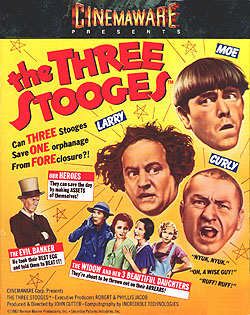
The Three Stooges is a video game released by Cinemaware in 1987 for the Amiga based on the comedy trio of the same name. Players control Stooges Moe, Larry, and Curly in minigames based on Stooges films with the aim of raising enough money to save an orphanage. It was ported to the Apple IIGS, Commodore 64, MS-DOS, NES and Game Boy Advance. The game has been praised as a faithful adaptation of the Stooges films, but has been criticized for repetitive gameplay and limited replay value.

Jungle Strike is a video game developed and published by Electronic Arts in 1993 for the Sega Genesis. The game was later released on several other consoles such as the Super Nintendo Entertainment System (SNES), and an upgraded version was made for DOS computers. The Amiga conversion was the responsibility of Ocean Software while the SNES and PC DOS versions were that of Gremlin Interactive, and the portable console versions were of Black Pearl Software. It is the direct sequel to Desert Strike and is the second installment in the Strike series. The game is a helicopter-based shoot 'em up, mixing action and strategy. The plot concerns two villains intent on destroying Washington, D.C. The player must use the helicopter and occasionally other vehicles to thwart their plans.

There have been several video games based on the 1991 film Hook. A side-scrolling platform game for the Nintendo Entertainment System (NES) and Game Boy was released in the United States in February 1992. Subsequent side-scrolling platform games were released for the Commodore 64 and the Super Nintendo Entertainment System (SNES), and an arcade beat ‘em up by Irem later in 1992, followed by versions for the Sega CD, Sega Genesis, and Sega's handheld Game Gear console in 1993.
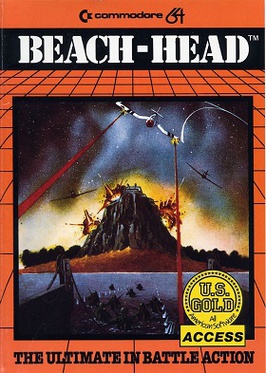
Beach-Head is a video game developed and published in 1983 by Access Software for the Atari 8-bit computers and Commodore 64 in the US. Versions for the ZX Spectrum, BBC Micro, and Acorn Electron were published in Europe by U.S. Gold in 1984, followed by versions for the Amstrad CPC, Commodore 16 and Plus/4 in 1985.
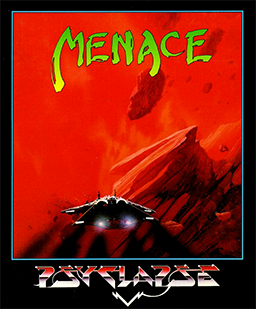
Menace is a horizontally scrolling shooter developed by DMA Design and published by Psygnosis. It was released for the Amiga and Atari ST in 1988, and for the Commodore 64 and MS-DOS in 1989. The game is set on the planet of Draconia, where players are tasked with destroying the planet's defence mechanisms in order to kill the harmful creatures.

Spot: The Video Game is a video game developed and produced by Virgin Mastertronic in 1990/1991 for the Amiga, Atari ST, MS-DOS computers, Game Boy and NES. It is the first video game to feature the then-current 7 Up mascot "Spot", and was later followed up by platformers Cool Spot and Spot Goes To Hollywood.

Cloud Kingdoms is a puzzle game published by Millennium Interactive for the Amiga, Atari ST, Commodore 64, and MS-DOS in 1990. The player controls Terry, a green bouncing sphere, on a quest to recover his magic crystals that have been stolen by Baron von Bonsai. To do so, he must travel through the eponymous Cloud Kingdoms, avoiding enemies and hazards while collecting all of the crystals within the game's time limit. The game was developed by Dene Carter at Logotron, with sounds and music composed by David Whittaker.

Sex Vixens from Space is an erotic interactive fiction game developed and self-published by Free Spirit Software and originally released in 1988 for the Commodore 64 and Apple II as part of the compilation Sex And Violence Vol. 1. It was released as a standalone game, with the addition of graphics, in November 1988 for DOS and Amiga and in 1989 for the Atari ST. Sex Vixens was inspired by the 1974 sexploitation film Flesh Gordon. The game was panned by reviewers.
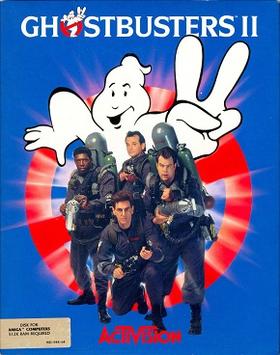
Ghostbusters II is a 1989 action game based on the film of the same name. It was published by Activision for various computer platforms. British studio Foursfield developed a version for Commodore 64, Amiga, Atari ST, Amstrad CPC and ZX Spectrum, which also got ported to the MSX by New Frontier. It features three levels based on scenes from the film. Dynamix developed a separate version for the DOS, also based on the film. The non-DOS versions were praised for the graphics and audio, but criticized for long loading times, disk swapping, and the final level. The DOS, Commodore 64 and Amiga versions were the only versions released in North America.

Links: The Challenge of Golf is a golf video game developed by Access Software. It was published for MS-DOS in 1990, followed by the Amiga in 1992. A Sega CD version, developed by Papyrus Design Group, was released in 1994. It is the first game in the Links series, and was followed by Links 386 Pro (1992). A Microsoft Windows version, titled Microsoft Golf, was released in 1992 as the first game in the Microsoft Golf series.
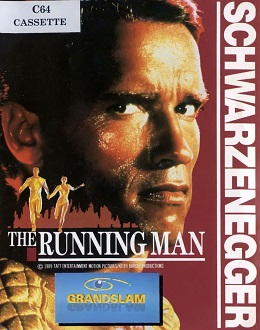
The Running Man is a 1989 beat 'em up video game based on the 1987 film of the same name. It was developed by Emerald Software and published by Grandslam Entertainments for Amiga, Amstrad CPC, Atari ST, Commodore 64, and ZX Spectrum.

Terminator 2: Judgment Day is a 1991 action video game developed by Dementia and published by Ocean Software. It is based on the 1991 film of the same name, and was released in Europe for Amiga, Amstrad CPC, Atari ST, Commodore 64, DOS, and ZX Spectrum. It is a sequel to The Terminator, itself based on the 1984 film of the same name. The game features several gameplay styles such as driving, fighting, and puzzle-solving.
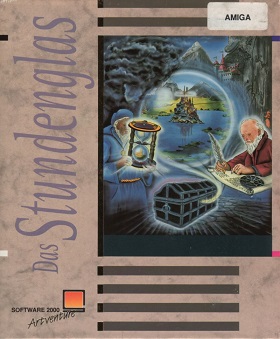
Das Stundenglas is a German text adventure game published in 1990 by Software 2000 and developed by Weltenschmiede, and released for Amiga, Atari ST and DOS. Das Stundenglas is part of a text adventure trilogy; it is succeeded by Die Kathedrale (1991) and Hexuma (1992). The trilogy lacks an overarching plot, and in each entry the setting, role of the protagonist, and goal differ between each game. Games in the trilogy do not require knowledge of the other entries and may be played as standalone games.

Sex Olympics, alternatively titled Brad Stallion in Sex Olympics is an erotic point-and-click adventure game developed and self-published by Free Spirit Software, and released for DOS, Atari ST, and Amiga. The Amiga version of Sex Olympics was released in Europe in April 1991. Sex Olympics is the finale of the Brad Stallion series, and is preceded by Sex Vixens from Space (1988), Planet of Lust (1989), and Bride of the Robot (1989). Sex Olympics was panned by reviewers.

Cover Girl Strip Poker, alternately titled Cover Girl Poker, is a 1991 erotic video game based upon five-card strip poker and originally developed and self-published by Emotional Pictures; it was released for the Amiga, DOS, Commodore 64, CDTV, and CD32. Cover Girl Strip Poker is the original Danish title; it was retitled Cover Girl Poker outside of Denmark in the rest of Europe, and the title was subsequently reverted to Cover Girl Strip Poker for the European CDTV and CD-ROM DOS releases. Emotional Pictures was a subsidiary of Danish company InterActive Vision A/S.

Carlos Sainz: World Rally Championship is a 1990 racing video game co-developed by the Spanish companies Zigurat Software and Arcadia Software, and published by Zigurat for Amstrad CPC, MS-DOS, MSX and ZX Spectrum. Featuring Spanish rally driver Carlos Sainz and themed around rallying, the game pit players with races across various locations to qualify for the next course in the World Rally Championship and modify characteristics of the Toyota Celica to accommodate each courses.

Sito Pons 500cc Grand Prix is a 1990 racing video game developed and published by the Spanish company Zigurat Software for Amstrad CPC, MS-DOS, MSX and ZX Spectrum. Featuring former Spanish racer Sito Pons and themed around motorcycle racing, the game pit players driving the Honda NSR500 with races against AI-controlled opponents across various countries to qualify in the 500cc class of the Grand Prix motorcycle racing.





















